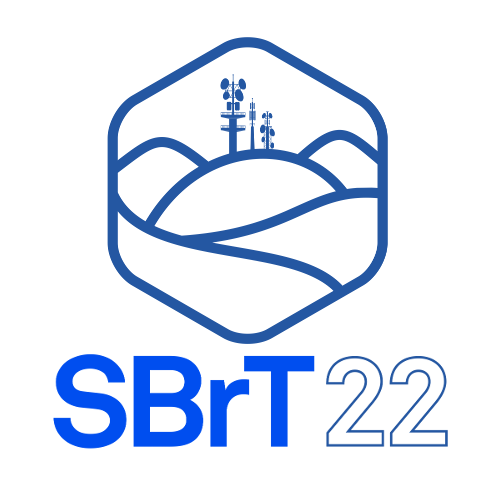
XL Simpósio Brasileiro de Telecomunicações e Processamento de Sinais

Desenvolvimento de um middleware IoT distribuído com foco em smart grids
Marcio da Silva Maciel, Alan Petrônio Pinheiro, Daniel de Oliveira Ferreira, Alailton José Alves
DOI: 10.14209/sbrt.2022.1570825022
Keywords: Middleware Redes Elétricas Internet das coisas smart grids
Abstract
Os sistemas elétricos de potência vem passado por um processo de modernização conhecido como smart grids. Ele está associado à digitalização da rede elétrica e monitoramento em larga escala. E a tecnologia de internet das coisas promete ajudar neste processo. Neste artigo é proposto um middleware distribuído para as redes elétricas com foco em tecnologias de comunicação heterogêneas e monitoramento em tempo real usando recursos de Complex Event Processing (CEP). A solução busca prover escalabilidade, redundância e padronização das mensagens para ajudar a prover interoperabilidade. Os resultados apresentados por meio de modelagem e simulação nos cenários avaliados demostram a viabilidade desta tecnologia para monitoramento em larga escala.Download
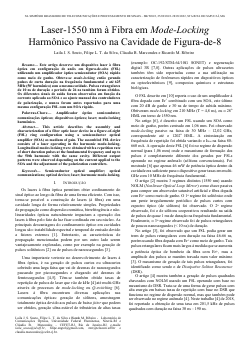
Laser-1550 nm à Fibra em Mode-Locking Harmônico Passivo na Cavidade de Figura-de-8
Laila Jorge de Sousa Souto, Ricardo Marques Ribeiro, Claudia Barucke Marcondes, Filipe Lopes Tenreiro da Silva
DOI: 10.14209/sbrt.2022.1570825025
Keywords: harmonic mode-locking Laser Semiconductor optical amplifier optical communications
Abstract
This article describes the assembly and characterization of a fiber optic laser device in a figure-of-eight (F8L) ring configuration using a semiconductor optical amplifier (SOA) as medium of gain. The assembled F8L device consists of a laser operating in the harmonic mode-locking. Longitudinal modes locking were obtained with a repetition rate of short duration pulses at the fundamental frequency and up to the 50th harmonic with the same cavity. Different output patterns were observed depending on the current applied to the SOA and the adjustment of the polarization controllers.Download
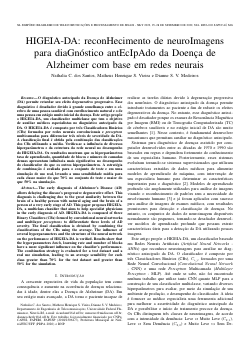
HIGEIA-DA: reconHecimento de neuroImagens para diaGnóstico antEcIpAdo da Doença de Alzheimer com base em redes neurais
Nathalia C dos Santos, Matheus Henrique Vieira, Dianne Medeiros
DOI: 10.14209/sbrt.2022.1570825026
Keywords:
Abstract
O diagnóstico antecipado da Doença de Alzheimer (DA) permite retardar seu efeito degenerativo progressivo. Esse diagnóstico é desafiador devido à grande semelhança entre o cérebro de uma pessoa saudável com envelhecimento natural e o de uma pessoa em estágio muito inicial da doença. Este artigo propõe o HIGEIA-DA, um classificador multiclasse que tem o objetivo de auxiliar médicos especialistas no diagnóstico antecipado da DA. O HIGEIA-DA é composto por três Classificadores Binários (CBs) formados por redes neurais convolucionais e perceptron multicamadas para diferenciar três níveis de severidade da DA. A classificação final é obtida pela combinação das classificações dos CBs utilizando a média. Verifica-se a influência de diversos hiperparâmetros e da estrutura da rede neural no desempenho do HIGEIA-DA. Os resultados mostram que os hiperparâmetros taxa de aprendizado, quantidade de blocos e número de camadas densas apresentam influência mais significativa no desempenho do classificador do que os outros hiperparâmetros. A estratégia de combinação é avaliada para o conjunto de teste e em uma simulação de uso real, levando a uma sensibilidade média para cada classe maior do que 70% no conjunto de teste e maior do que 50% na simulação.Download
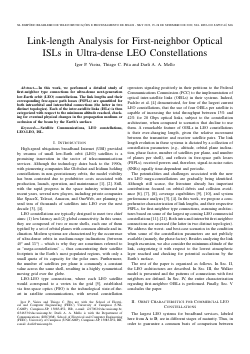
Link-length Analysis for First-neighbor Optical ISLs in Ultra-dense LEO Constellations
Igor P. Vieira, Thiago C. Pita, Darli Mello
DOI: 10.14209/sbrt.2022.1570825033
Keywords: Satellite Communications LEO constellations LEO-LEO ISL
Abstract
In this work, we performed a detailed study of first-neighbor type connections for ultra-dense next-generation low-Earth orbit (LEO) constellations. The link lengths and their corresponding free-space path losses (FSPLs) are quantified for both intraorbital and interorbital connections (the latter in two distinct topologies). Each of the inter-satellite links (ISLs) is then categorized with respect to the minimum altitude reached, checking for eventual physical changes in the propagation medium or occlusion of the beam by the Earth's surface.Download
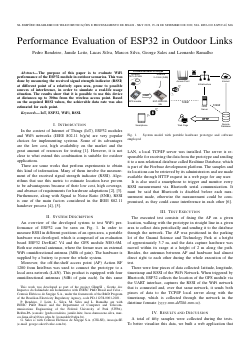
Performance Evaluation of ESP32 in Outdoor Links
Pedro Rendeiro, Jamile L Leite, Lucas Silva, Marcos Silva, George Sales, Leonardo Ramalho
DOI: 10.14209/sbrt.2022.1570825034
Keywords: IoT ESP32 WiFi RSSI
Abstract
The purpose of this paper is to evaluate WiFi performance of the ESP32 module in outdoor scenarios. This was done by measuring the received signal strength indicator (RSSI) at different point of a relatively open area, prone to possible sources of interference, in order to simulate a real-life usage situation. The results show that it is possible to use this device at distances up to 300m from the wireless access point. Based on the acquired RSSI values, the achievable data rate was also estimated for each point.Download
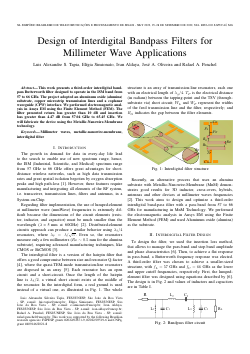
Design of Interdigital Bandpass Filters for Millimeter Wave Applications
Luis Alexandre S Tapia, Elígia Simionato, Ivan Aldaya, Jose Augusto de Oliveira, Rafael Abrantes Penchel
DOI: 10.14209/sbrt.2022.1570825063
Keywords:
Abstract
This work presents the design of a third-order band-pass interdigital filter with Butterworth response designed to operate in the ISM band from 57 to 66 GHz. The project adopted an aluminum oxide (alumina) substrate, copper microstrip transmission lines and a CPW interface. We performed electromagnetic analysis in Ansys EM using the Finite Element Method (FEM). The filter presented return loss greater than 10dB and insertion loss greater than 4.47dB from 57.04 GHz to 65.45 GHz. We will fabricate the device using the Metallic-Nanowire-Membrane Technologic.Download

Detection of Zika virus infection on mosquitoes using spectroscopy and machine learning
Leonardo Reigoto, Rafael Freitas, Gabriel Araujo, Amaro de Lima
DOI: 10.14209/sbrt.2022.1570825065
Keywords: Zika virus Machine Learning Linear Discriminant Analysis Support Vector Machine
Abstract
This work shows a method to classify mosquitoes infected with the Zika virus. We accomplish that by using spectroscopy and machine learning. Our model takes the light absorbance of wavelengths from 350 to 1000 nm as inputs. It employs a combination of Linear Discriminant Analysis (LDA) of the windowed version of the signal (to take advantage of nonlinearities) and Support Vectors Machine (SVM) to classify the samples. The proposed method can detect the presence of the Zika virus with 100% accuracy in less than 7 days post-infection. The accuracy drops to 77.7% when 10 days have passed. The main advantages are the low cost and the possibility to make predictions in real-time.Download